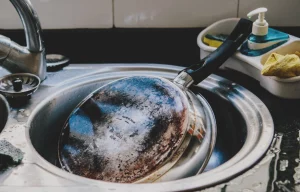
It has happened to everyone. You left the food on the stove for too long, or used the wrong pan – it all results in a horrible burnt, hard-to-remove mess that no one likes to deal with. While some new high-tech pots and pans have a special coating that allows you to clean them with a simple wipe, regular utensils are much harder to clean up. Cleaning those can be tricky especially because you need to scrub hard enough to be able to remove the grime but not too hard to scratch the surface of your pot. Steel wool, for example, should never be used on non-stick pots and pans.
In this article, we will share some easy tricks to get rid of the burnt grime on the bottom of your favourite pan using everyday household products while causing no damage.
Those include baking soda, dryer sheets, Alka-seltzer, vinegar, and dish soap.
While the steps you will find below will work for most pots and pans, there are, of course, some exceptions. You should never use abrasive methods when attempting to clean a non-stick pot. You will cause scratches and ruin the non-stick properties of the utensil. Dishwashers and dishwasher cleaning solutions are also to be avoided since they are too harsh for non-stick coating.
Another type of pot you should be careful with is cast iron. Avoid prolonged soaking and excess moisture exposure since those may rust. Safe methods for cast iron utensils are baking soda and lemon, vinegar, and dryer sheets.
Baking soda and vinegar method
The combination of those two products causes a powerful and efficient solution that will successfully loosen the burnt-on grime. The other strong point of this method is the abrasiveness that comes from baking soda. Along with the chemical reaction, it will make your pots shiny again.
- Boil a 1:1 solution of vinegar and water in the pan.
- Remove the pot from the heat, remove the liquid and sprinkle some baking soda. Once the pot has cooled down, add more baking soda and scrub it gently with a sponge.
Baking soda and dish soap method
Similar to the one above, this method has a double action. Apart from the degreasing properties of the dishwashing liquid, the mild abrasion that comes from baking soda will efficiently get rid of the grime that has built up at the bottom of your pot.
- Mix ½ cup of baking soda, ½ cup of warm water, and a tablespoon of dish soap. Pour it into the pot and let it soak for an hour.
- Scrub the bottom of the pot with a plastic scrubber.
- Repeat for stubborn grime if needed.
Alka-seltzer method
Not only is it great for indigestion, but this amazing product is perfect for cleaning a number of things around the house, including burnt pots and pans.
- Fill your pot with very hot water, then add a couple of Alka-seltzer tablets to it. Let them sit for an hour. The citric acid in the tablets will help dissolve the stubborn grease.
- Pour the solution out and use hot water and dishwashing detergent to gently remove the rest of the burnt-on residue.
Dryer sheets cleaning method
Even though this method may seem a little strange, it is extremely efficient. The best part is, that it is the gentlest method of all the ones we will talk about. It is suitable for all kinds of pots and pans so give it a try next time you struggle to clean them.
- Pour enough hot water into the pot/pan to cover the grimy area. Place a dryer sheet or two (they should cover the whole bottom).
- Let it sit for a couple of hours or overnight (depending on the severity of the grime).
- Use the dryer sheet to wipe away the grease. That way you will be able to remove the dirt in a gentle, non-abrasive way
Baking soda and lemon cleaning method
Using a real lemon along with baking soda is another natural, gentle, yet effective method that will help you fight against the harsh burnt grime. The reaction between the two will break down the grease and will loosen the dirt.
- Soak the pot in hot water for a few minutes (unless it is cast iron)
- Cut a lemon in half and dip one of the halves into baking soda.
- Use it to scrub the nasty grime.
How to prevent pot burns in the first place:
- One of the most important strategies to avoid pot burn is to thoroughly oil the bottom of your pan before cooking and to wait until the pan has reached temperature before adding your meal. Food adheres to the bottom of a cold or dry pan more easily, resulting in more charred portions towards the conclusion of the cooking cycle.
- When browning chicken or other meat, let it brown before adjusting it, since moving under-brown skin can cause it to adhere and rip, resulting in more burnt pieces at the end.
- When you’re done cooking and the pan is still hot, add a 1/2 cup of water or wine to deglaze it and scrape out any food crumbs with a wooden spoon. This not only helps to clean, but it might also be the beginning of a fantastic finishing sauce if your bits aren’t too scorched.
